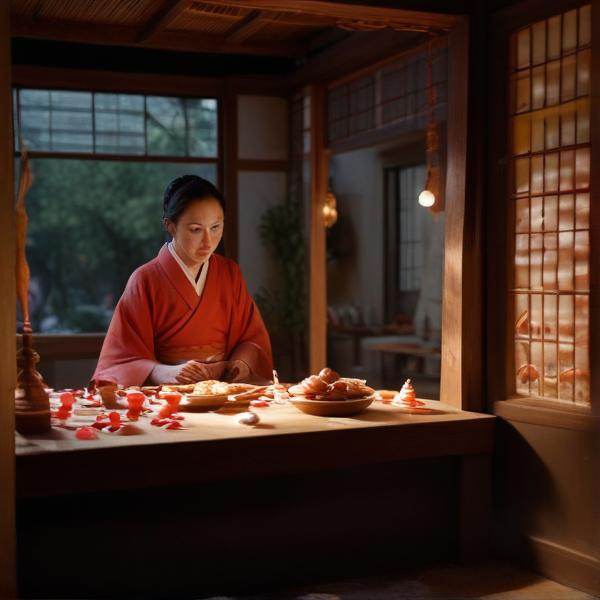基本信息 (Basic Information)
含义与用法 (Meanings & Usage)
中文核心释义 (Core Chinese Meaning): 颜色,色彩;外表;也指与性有关的事物或情感
英文核心释义 (Core English Meaning): color, hue; appearance; sometimes refers to things or feelings related to sexuality
象形意义 / 为何这么写 (Pictographic Meaning / Writing Rationale)
文言文释义 (Classical Chinese Meaning)
深入学习 (In-depth Study)
字源故事 (Origin Story)
字形演变 (Character Evolution)
常用词语和例句 (Common Words & Examples)
颜色 (color; hue)
你最喜欢什么颜色?
Eng: What is your favorite color?
色彩 (color; coloring; tone (can also mean artistic style or feeling))
这幅画的色彩非常丰富。
Eng: The colors in this painting are very rich.
面色 (complexion; facial color)
他的面色看起来不太好。
Eng: He looks pale (his complexion doesn't look good).
色情 (erotic; pornographic)
这本书包含色情内容。
Eng: This book contains erotic content.
相关成语 (Related Idioms)
色厉内荏
Meaning: a harsh outward appearance but weak inside; a bluff
多语言翻译 (核心释义) (Translations (Core Meaning))
- French: couleur
- German: Farbe
- Spanish: color
- Italian: colore
- Portuguese: cor
- Russian: цвет
- Arabic: لون
- Persian: رنگ
- Dutch: kleur
- Polish: kolor
- Vietnamese: màu sắc
- Ukrainian: колір
视频学习资源 (Video Learning Resources)
通过以下链接在热门视频网站搜索 "色" 的更多讲解:
Search for more explanations of "色" on popular video sites:
- 在 Bilibili.com 搜索 "色 字源 说文解字" (Search on Bilibili)
- 在 YouTube.com 搜索 "色 character origin etymology" (Search on YouTube)
网络参考 (Web References for "色") ()
网络内容摘要 (Web Content Summary):
核心含义与象形起源:“色”本义为脸色、气色,与面部表情和情绪状态密切相关,表现为“心达于气,气达于眉间是之谓色”。在甲骨文中,“色”字形似两人亲密接触,早期也有与生理、本能欲望相关的象形意义。Core meaning & pictographic origin: The original meaning of “色” is complexion or facial expression, closely tied to emotions. The ancient script depicts two people in close contact, also representing instinctual or physical desires.
文化背景与演变: 在古代,“色”常用来描述精神状态、气色与和气,如“愉色”、“婉容”等词形容神情温和愉悦。随着时间推移,“色”还引申为颜色(如红色、绿色)及情欲之意(如“好色”)。Cultural background & evolution: In ancient times, “色” referred to one’s look and emotional state, used in words meaning gentle or pleasant expression. Over time, it also came to mean “color” (like red, green) and desire (e.g., in the term for lust).
- 常见易混与表达: “色”易与单纯的颜色混淆,但在不同语境下,也指神情、气色或情欲。如“脸色” (facial expression/complexion)、 “色彩” (color)、 “好色” (lustful) 等常用词。 Common confusions & usage: The word may refer to mere “color” or also emotion/facial expression/desire depending on context, as in “脸色” (complexion), “色彩” (color), and “好色” (lustful).
相关成语包括“面不改色”(形容镇定自若),强调与表情相关的用法。 Related idioms include “面不改色” (maintaining an unchanged facial expression), highlighting the usage related to expressions.
小结: “色”既可指物体的颜色,也与人的情绪、神情、乃至欲望息息相关。学习时应结合语境,辨别其准确涵义。 Summary: “色” can mean both “color” and “emotions/expressions/desires”; understanding the meaning depends on the context.
色的解释|色的意思|汉典"色"字的基本解释 - 漢典
(色) 顏气也 顏者,兩眉之閒也。 心達於气,气達於眉閒是之謂色。顏气與心若合符卪,故其字从人卪。記曰:孝子之有深愛者,必有和气,有和气者必有愉色,有愉色者必有婉容,又曰:戎容,盛氣闐實陽休。
【色】的甲骨文金文篆文字形演变含义 - 甲骨文研究网 甲骨文密码字典 在线甲骨文字典研究 - 甲骨文研究网 甲骨文密码字典 在线甲骨文字典研究 认路
甲骨文密码 【甲骨密码】 色:引導至同一戰線。 【其他解读】 色,甲骨文 = (人)+ (人),字形像两人一前一后,亲密接触。 信阳楚简字形 像一个人抓住 一个俯卧的人,表示正在进行性活动,在俯卧的人的下部加一短横,代表性器官所在。 篆文=(人,体位在上)+(人,体位在下),进一步 ...
更多图片 (色 More Images) ()
